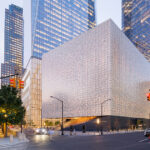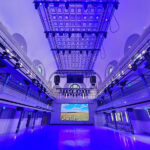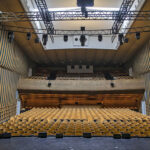Within the last two decades, Las Vegas has seen a cycle of high-stakes one-upsmanship among the casinos lining the Strip, with aging casinos imploding to make way for full-service resorts that have become world-class destinations for gambling, fine dining and relaxing in the sun. The competition to fill the seats of the vast casino showrooms is no less intense.
The various Cirque du Soleil productions in town now play to an audience of 9,000 or more per night, and audiences are expecting the same kind of crowd-pleasing visual spectacles for musical performances as well. Caesars Palace took note and hired former Cirque du Soleil director Franco Dragone for A New Day…, the musical spectacular featuring Céline Dion, which opened in 2003. It also built a new theatre specifically for that show, the 4,148-seat Colosseum, which played before sellout crowds regularly through 2007.
So how do you top a show that enjoyed a five-year run, with a 73 percent sellout rate and ticket sales in the $400 million range? Caesars’ solution was to sign three of the biggest draws in the music biz — Cher, Elton John and Bette Midler — give each of them a spectacular set, and have them rotate their performances throughout the season.
“With an artist as versatile as Cher it is important that the technology is equally as versatile,” says Baz Halpin, lighting director for Cher. “Whether Cher is on our customized longboat in a lake of smoke singing the mesmerizing ‘After All’ or belting out ‘Turn Back Time’ to a screaming audience, we have tried to create a show which both captures the intimacy of a theatre and delivers the large scale punch of arena rock. Cher has the audiences dancing on their seats every night without fail.”
The production and design teams for all three shows — Cher at the Colosseum at Caesars Palace, Elton John’s The Red Piano and Bette Midler’s The Showgirl Must Go On — worked in concert to come up with plans and equipment lists that would allow the shows to rotate in and out easily throughout the 2008 performance season. Initial meetings for lighting and set design came about a year prior to the first show, with pre-production design for Cher’s show beginning in earnest about eight months before opening.
“The design team spent a long time discussing the concepts before we ever put pen to paper, so there were very few changes,” says Halpin. “I think we are on version four of the plot, which is a testament to in-depth discussion and ensuring a full understanding of the vision before starting to add lights to a plot.”
Doing hand illustrations and using tools like AutoCAD, Photoshop, VectorWorks, SketchUp and 3DS Max, the team went to work creating a design that would maximize the flexibility of The Colosseum and allow for quick load-ins and load-outs as the shows rotate. Cher production designer Jeremy Railton says his main goal was making Cher happy so she could enjoy herself onstage.
“It’s all to make a comfortable environment for the performers that tells the story of the show,” he says. “Theatrical events should happen seamlessly and not stop the show and overshadow the performers.”

Cher’s fans have come to expect “glittery rock ‘n’ roll with plenty of spectacle,” says Railton, and he made sure his design delivers just that to Las Vegas audiences. With three different shows sharing the same venue, space had to be used as efficiently as possible. The lighting designers for Cher, John and Midler agreed on a kit list that would satisfy the needs of each performer.
“Each show had to be visually polemic due to the nature of the artists, but all three shows had the same 120-foot video wall and the same stock of lighting equipment to design from,” Halpin says.
The Cher equipment list includes 95 Coemar Infinity Wash fixtures, 60 Vari*Lite VL3000 Spots, 24 VL3500 Spots, 24 VL2202 Spots, 39 VL3500 Wash fixtures, 46 Clay Paky Profile SVs, 14 Syncrolites, six Robert Juliat followspots, one Lycian 3K followspot, 14 Martin Atomic 3K Strobes, two Hungaro Strobes, 24 Color Kinetics ColorBlasts and 18 Chroma-Q Color Blocks. There are also six Pixel Range PixelLine LEDs, 34 4-lighters, 20 police beacons, 120 strings of twinkle lights, 12 Pathway 4-Port Nodes and one Martin Maxedia Pro media server.
“The lighting is not consistent from show to show,” explains Caesars Palace Colosseum technical director Bob Sandon. “It’s a different hang for each of them. Bette and Elton are similar, but between Bette and Cher, it’s completely reworked. The pieces are all there, just assembled a little different.”
In designing the lighting for Cher’s show, Halpin wanted to create a variety of styles within a single space. “We move from arena rock to West End theatre to Vegas glitz,” he describes, “so it was important that the lighting was flexible and dynamic enough to work within all disciplines.”
Halpin uses a Studio Due Dominator to backlight a giant pearl in which Cher makes her entrance.
“It’s a 6K Xenon breakup fixture which literally dominates the stage,” he says. “We also use 40 Jem Hydra smoke machines with steam fluid to create smoke chases and a faux CO2 effect for the battlefield scene.”
Smoke and confetti are consistent across all three shows and additional special effects for Cher include full color lasers from LaserNet. LED fixtures internally light the individual set pieces for Cher’s show, and Halpin uses ColorBlasts and DB4s to illuminate band members and band risers.
“I like LEDs both for their low power consumption and low heat, which means I can position them closer to soft goods,” Halpin says. “With LED technology moving forward at such a rapid pace, I am sure lighting rigs will become more and more efficient and environmentally friendly.”
All told, The Colosseum went from 12 lighting universes for the Céline Dion show to 31 universes for the 2008 season. The Cher and Midler shows are controlled through two Martin Maxxyz+ consoles, and the Elton John show uses an MA Lighting grandMA. ETC Sensor Dimmer racks — with 1,348 dimmers — were chosen for their versatility and reliability.
“It is all Ethernet based. All demultiplexing and signal processing is in-built within The Colosseum and runs throughout the building,” says Halpin.
All three shows make use of the house rigging, which Halpin describes as a combination of Niscon digitally controlled linesets and conventional hoists and trusses. The load-in for the Cher show took about two weeks, including rehearsals.
For Halpin, working in Las Vegas and in The Colosseum for the first time presented some challenges.
“It is obviously much larger than a conventional theatre yet it still has more restrictions to design than an arena,” he says. Halpin was encouraged by the amount of atmospheric and ambient light control The Colosseum offers, but he still had to deal with lighting one of the biggest proscenium spaces in the country.
“This is a huge performance space to light properly without overlighting,” Halpin says. “It was quite challenging in the design process to ascertain the best fixture placement in order to get big rock and roll cathedral looks while at the same time ensuring that we are not bombarding the audience consistently with high-powered lighting.”
For Cher at the Colosseum, the set design calls for creating a false proscenium through the use of two 45-foot on-stage towers — designed by Tait Towers — that close the space to a more manageable 72-feet and create a visually dynamic set.
“We can go from small and intimate, to action that spans 140-feet across the stage and 40-feet vertically,” Halpin says.
Railton says that designing for a permanent stage is usually easier and less expensive than designing for a touring production, but this particular show has to be a blend of both.
“The three shows all are sharing the theatre. Although we load out most of the scenery, some of the heavy stuff remains,” Railton explains. “The difficulty was to squeeze in our scenery on top of the other two shows.”
For Sandon, the biggest challenge was “finding space for everyone’s production and still try to create ease of load-in and load-out so we don’t necessarily have to completely remove an entire show.”
One solution was to leave some elements in place — like the lettering for the Elton John show that remains hanging in the grid during performances by Cher and Midler.
“You leave some things behind just so you can rotate the shows quickly,” Sandon explains.
The real test of the design comes when it’s time to rotate the shows — taking down one show and loading the next one in, all in just over 24 hours. The three artists rotate performances throughout the 2008 season, with Midler’s show running about four weeks at a time, Elton John at two to three weeks and Cher with a five to six week run.
And each performer has a completely different set.
“The only thing that doesn’t move is the video wall. It's permanently fixed in place,” says Sandon. “There are new drops, new lighting positions, new scenery and even a different floor layout. Bette has one giant riser onstage, and then Cher has the bridge and towers and everything else. It’s a completely different look from show to show.”
And time is of the essence.
“We have a day,” Sandon says. “We close on Sunday nights, and then we have a Tuesday show, all the time.”
As an example, Sandon expects the Cher show to load out in about six or seven hours. “Then we’ll have to work pretty much sixteen hours the next day to put it back in,” he says.
For Halpin, working in The Colosseum couldn’t have been better.
“Putting together one show like this, never mind three shows, would not be possible in some venues,” he says. “Head electrician Greg Whittle and his team have made this one of the most painless experiences of my career. The attention to detail and can-do attitude meant a potentially difficult and stressful situation was in fact a thoroughly enjoyable one. It was almost too easy.”
Sandon is happy to host Cher, Midler and John at Caesars Palace. He believes The Colosseum and its three rotating performers — with diverse sets, styles and audiences — are a match made in heaven.
“It’s such a great complement. The building is laid out in such a way that there is no seat that’s further than 130 feet from basically the downstage center mic position,” he says. “It’s a great place to come see a show. The shows themselves just look great.”


